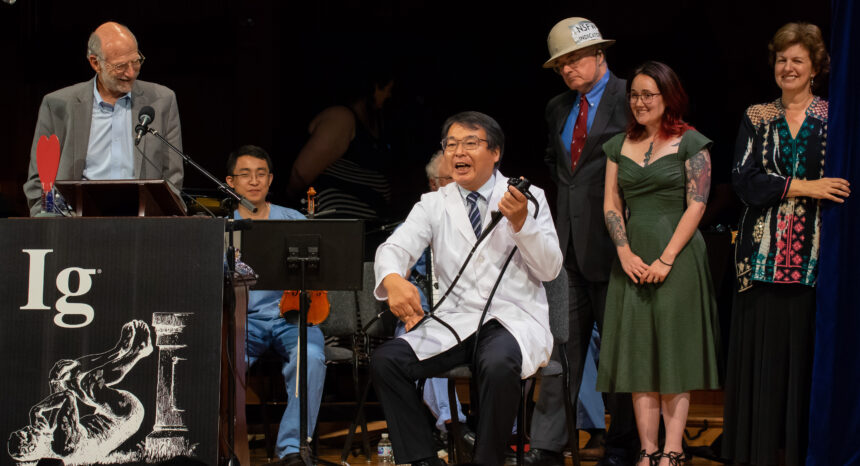Burning and stabbing voodoo dolls gives employees who’ve been mistreated by their bosses a feeling of justice, new research finds.
Lindie Liang, an assistant professor at Wilfrid Laurier University who led the study, said the idea for it sprung from earlier research showing employees tend to retaliate against bullying supervisors. She and a team of colleagues wanted to see if employees would benefit from torturing an online voodoo doll — a harmless act of symbolic retaliation.
The study was one of 10 recognized at this year’s Ig Nobel Prize ceremony, which also honored research on topics such as smelling flies in wine, the nutritional content of human flesh and self-colonoscopies. About 9,000 studies were nominated for the Ig Nobel Prize, a parody of the prestigious Nobel Prize that “celebrates the unusual, honors the imaginative, and spurs interest in science.”
When Liang’s research topic was announced, the crowd erupted in laughter. Some members of her research team carried voodoo dolls to the podium to accept their award for investigating the use of voodoo dolls to get even with bosses.
“People actually feel a lot better,” she told a crowd of about 1,000 people who had gathered Sept. 13 at Harvard University’s Sanders Theatre.
Actual Nobel laureates, including Harvard University economist Eric Maskin, congratulated the Ig Nobel winners on stage at the event, which also featured comedic skits, a deluge of paper airplanes and a Speedo-wearing human spotlight. Along with a heart-shaped trophy, the researchers received a cash prize: a 10-trillion-dollar bill from Zimbabwe.
Liang’s study, “Righting a Wrong: Retaliation on a Voodoo Doll Symbolizing an Abusive Supervisor Restores Justice,” was published in August 2018 in The Leadership Quarterly. While it has received a lot of media coverage, Liang said reporters sometimes get the facts wrong.
“There are definitely errors and misleading statements — for example, several news outlets seem to suggest that stabbing a voodoo doll makes employees happier and improves employee morale, etc.; our results don’t speak to employee satisfaction and job morale,” she explained in an interview with Journalist’s Resource.
Kees Moeliker, a Dutch ornithologist who helps judge the Ig Nobel competition, said the award helps highlight scholarship that might otherwise receive little attention. In an e-mail interview from Rotterdam, he said he has seen an uptick in the number of research studies nominated each year.
“The Ig Nobels are now marked in every scientist’s calendar,” wrote Moeliker, who’s also the European Bureau Chief of the science humor magazine Annals of Improbable Research, which produces the Ig Nobel awards ceremony. “Department heads send in work of colleagues, students nominate their professors.”
Moeliker recalled how more career opportunities opened for him after he won an Ig Nobel in 2003 for documenting the first case of homosexual necrophilia in a mallard duck.
“The world knows my interest in remarkable animal behavior and I got so much new exciting data,” he wrote. “Book contracts followed, and I even became director of the museum where I work. Before winning the Ig Nobel, only seven people had actually read my duck paper.”
Nobel Laureate Maskin said he helped with the program this year because he had so much fun last year. He also talked Michael Rosbash, a Brandeis University professor who won the Nobel Prize in Physiology or Medicine in 2017, into joining him.
“He’s a friend and I told him it would be a good laugh,” Maskin said.
A recording of the 28th First Annual Ig Nobel Prize Ceremony will soon be available on YouTube. An edited version will broadcast on “Science Friday,” which airs on hundreds of public radio stations nationwide, the day after Thanksgiving.
The other nine winning research studies are:
- “Assessing the Calorific Significance of Episodes of Human Cannibalism in the Paleolithic”: A study of cannibalism that finds that human meat has much fewer calories than meat from animals such as bison, cattle and horses.
- “Validation of a Functional Pyelocalyceal Renal Model for the Evaluation of Renal Calculi Passage While Riding a Roller Coaster”: A study that looks at roller coasters as a way to speed up the passage of kidney stones.
- “Spontaneous Cross-Species Imitation in Interactions Between Chimpanzees and Zoo Visitors”: An observational study that finds that chimpanzees in a zoo imitate human visitors about as often as human visitors imitate the chimpanzees.
- “Human Saliva as a Cleaning Agent for Dirty Surfaces”: A study that examines human saliva as an effective cleaning agent for removing dirt from 18th century sculptures.
- “Nocturnal Penile Tumescence Monitoring with Stamps”: A study that uses postage stamps as a screening test for impotence.
- “Colonoscopy in the Sitting Position: Lessons Learned from Self-Colonoscopy by Using a Small-Caliber, Variable-Stiffness Colonoscope”: A report that describes the ease and comfort of performing a self-colonoscopy.
- “Life Is Too Short to RTFM: How Users Relate to Documentation and Excess Features in Consumer Products”: A study that finds that most people don’t read instruction manuals, especially men and people with higher education levels.
- “Shouting and Cursing While Driving: Frequency, Reasons, Perceived Risk and Punishment”: A study that measures how often and why some Spanish drivers shout and curse while driving.
- “The Scent of the Fly”: A study of fruit flies that demonstrates that wine experts can detect, by smell, the presence of a female fruit fly in a glass of wine and that a fly can spoil a glass of wine, provided it’s female.
How to tell good research from flawed research: 13 questions journalists should ask
Covering health research? Choose your studies (and words) wisely


Expert Commentary